Management Economics Assessment 1
VerifiedAdded on 2023/06/18
|18
|4073
|51
AI Summary
This report discusses the application of economic concepts in managerial decision making in Procter & Gamble. It analyzes the factors of demand and price elasticity of demand for the company's Baby Wipes product range. The report concludes that the demand for the product is more inelastic due to its necessity nature. It also suggests the use of PESTLE analysis to identify external factors affecting business operations.
Contribute Materials
Your contribution can guide someone’s learning journey. Share your
documents today.
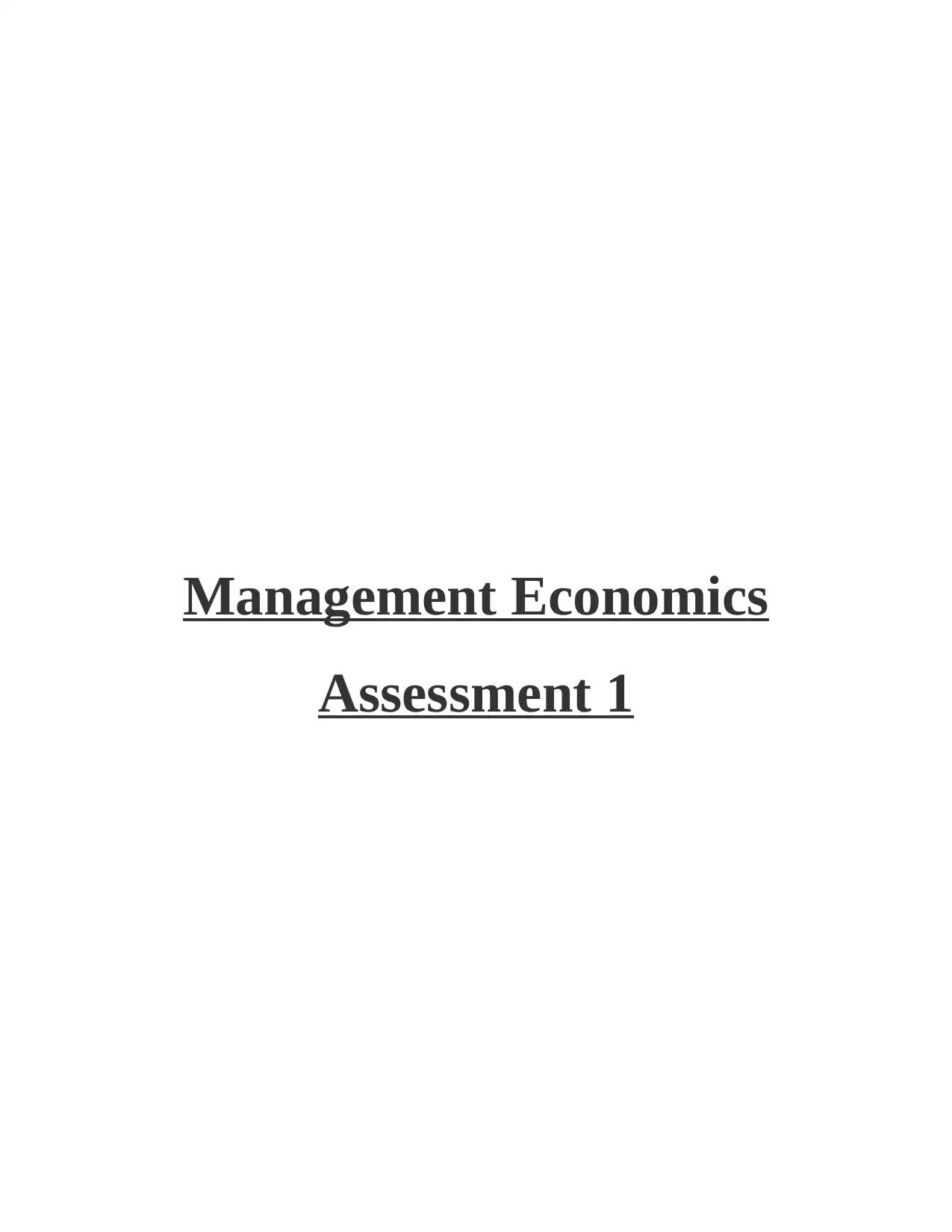
Management Economics
Assessment 1
Assessment 1
Secure Best Marks with AI Grader
Need help grading? Try our AI Grader for instant feedback on your assignments.
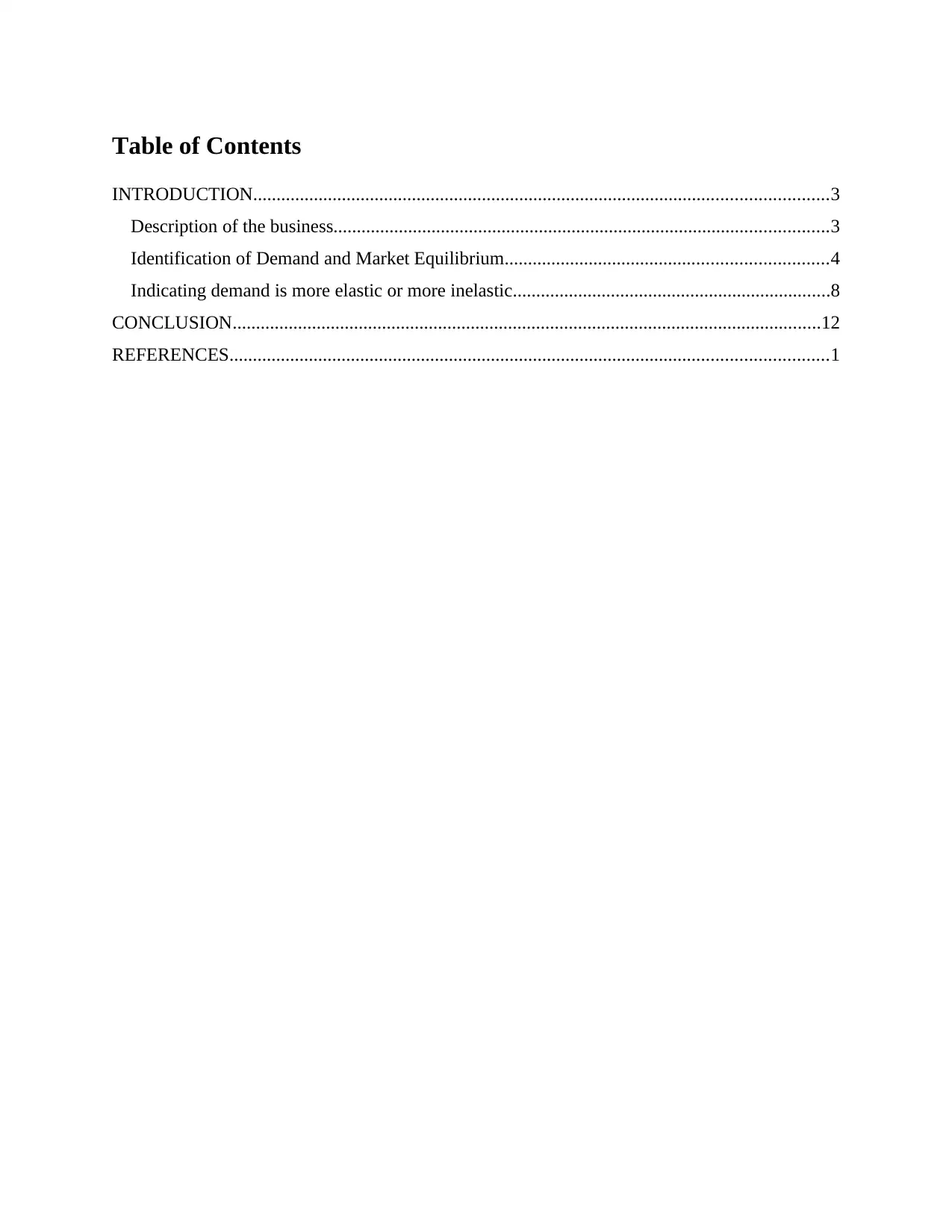
Table of Contents
INTRODUCTION...........................................................................................................................3
Description of the business..........................................................................................................3
Identification of Demand and Market Equilibrium.....................................................................4
Indicating demand is more elastic or more inelastic....................................................................8
CONCLUSION..............................................................................................................................12
REFERENCES................................................................................................................................1
INTRODUCTION...........................................................................................................................3
Description of the business..........................................................................................................3
Identification of Demand and Market Equilibrium.....................................................................4
Indicating demand is more elastic or more inelastic....................................................................8
CONCLUSION..............................................................................................................................12
REFERENCES................................................................................................................................1

INTRODUCTION
Managerial economics is a stream of management which help the companies in solving
their business problems and taking decisions via applying theories and principles of
microeconomics and macroeconomics. The report will critically discuss and apply the various
concepts of economics such as supply, demand, price elasticity etc. with respect to managerial
decision making in Procter & Gamble. Further, the report will also discuss the factors of demand
and price elasticity of demand and their impact on specific product range of company such as
Baby Wipes.
Description of the business
Procter & Gamble (P&G) is a American based multinational consumer goods
corporations which offers wide range of personal health, care and hygiene products to their
national and international customers. The company was founded in 1837 in Ohio whose product
portfolio also included food, snacks and beverages but main product is personal and skin care.
The company is operates in consumer goods industry having around 99000 employees in the
year 2020 with the operating income of US$16.39 billion (Bashir and et.al., 2019). Basically,
P&G operates in all around the world such as in more than 180 countries except the Cuba and
North Korea. The company offers variety of goods and services but the main products of the
company which will be focused in this report is Baby Wipes. It is because Pamper Baby wipes
product of the P&G in the year 2020 has total sales of 18.36 billion and in the year 2019 17.81
billion.
This product has more demand in the market as compared to company's other products
because it relates to the hygiene of the new born baby. The company offers baby wipes products
to the customers which are available on various fragrance and are also thick so that parents can
thoroughly clean their baby without reservations. The reason behind selecting Pampers Baby
Wipes product range offered by P&G company for the present report is that it is necessity
product not luxury (Sinaga and Sinulingga, 2020). This is a necessity product because it remove
the irritants on the baby skin after the regular use of diapers. The products price set by the P&G
company is low i.e., $0.03 per count as it is helpful for them to attract even middle class and
poor people to purchase it for the health and safety of their new born baby.
Managerial economics is a stream of management which help the companies in solving
their business problems and taking decisions via applying theories and principles of
microeconomics and macroeconomics. The report will critically discuss and apply the various
concepts of economics such as supply, demand, price elasticity etc. with respect to managerial
decision making in Procter & Gamble. Further, the report will also discuss the factors of demand
and price elasticity of demand and their impact on specific product range of company such as
Baby Wipes.
Description of the business
Procter & Gamble (P&G) is a American based multinational consumer goods
corporations which offers wide range of personal health, care and hygiene products to their
national and international customers. The company was founded in 1837 in Ohio whose product
portfolio also included food, snacks and beverages but main product is personal and skin care.
The company is operates in consumer goods industry having around 99000 employees in the
year 2020 with the operating income of US$16.39 billion (Bashir and et.al., 2019). Basically,
P&G operates in all around the world such as in more than 180 countries except the Cuba and
North Korea. The company offers variety of goods and services but the main products of the
company which will be focused in this report is Baby Wipes. It is because Pamper Baby wipes
product of the P&G in the year 2020 has total sales of 18.36 billion and in the year 2019 17.81
billion.
This product has more demand in the market as compared to company's other products
because it relates to the hygiene of the new born baby. The company offers baby wipes products
to the customers which are available on various fragrance and are also thick so that parents can
thoroughly clean their baby without reservations. The reason behind selecting Pampers Baby
Wipes product range offered by P&G company for the present report is that it is necessity
product not luxury (Sinaga and Sinulingga, 2020). This is a necessity product because it remove
the irritants on the baby skin after the regular use of diapers. The products price set by the P&G
company is low i.e., $0.03 per count as it is helpful for them to attract even middle class and
poor people to purchase it for the health and safety of their new born baby.
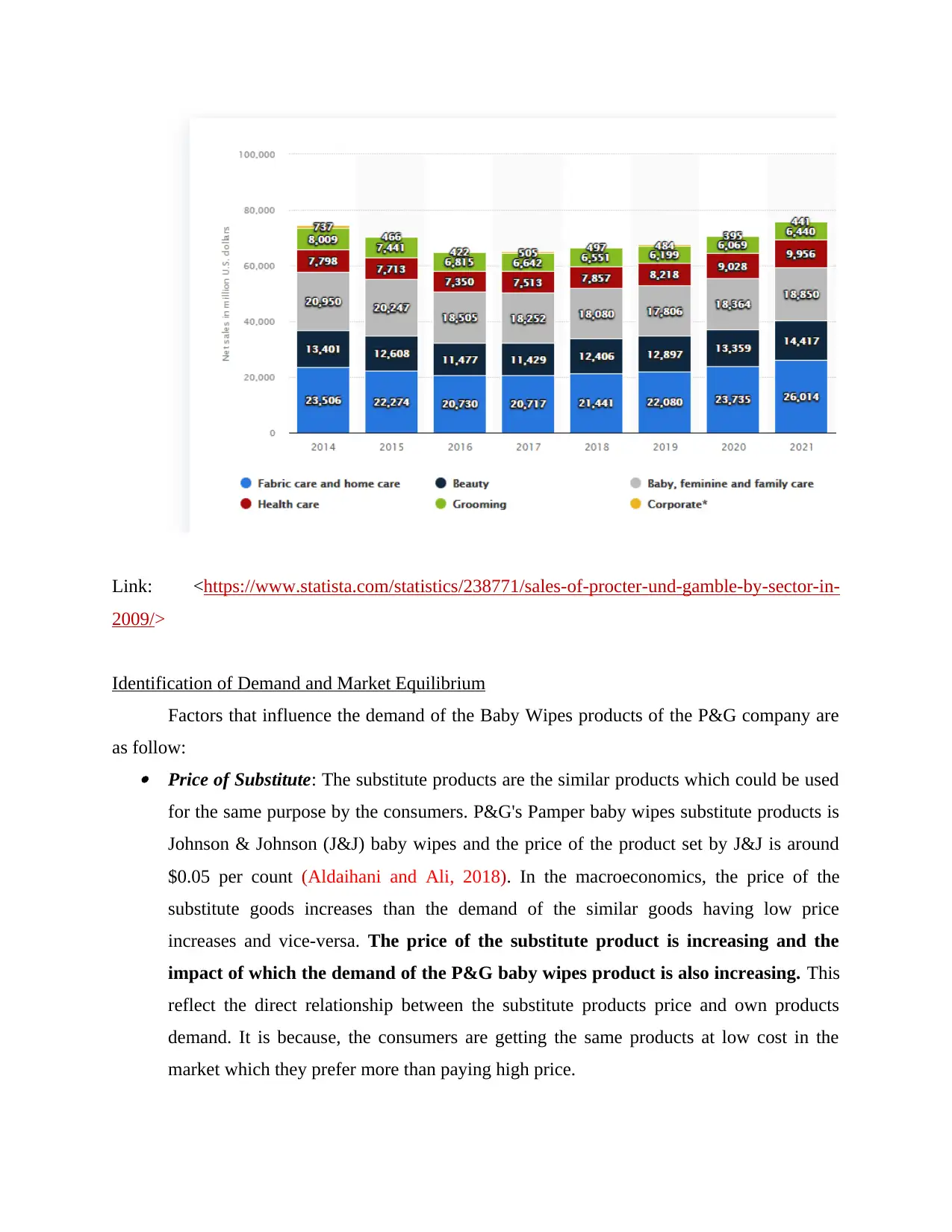
Link: <https://www.statista.com/statistics/238771/sales-of-procter-und-gamble-by-sector-in-
2009/>
Identification of Demand and Market Equilibrium
Factors that influence the demand of the Baby Wipes products of the P&G company are
as follow: Price of Substitute: The substitute products are the similar products which could be used
for the same purpose by the consumers. P&G's Pamper baby wipes substitute products is
Johnson & Johnson (J&J) baby wipes and the price of the product set by J&J is around
$0.05 per count (Aldaihani and Ali, 2018). In the macroeconomics, the price of the
substitute goods increases than the demand of the similar goods having low price
increases and vice-versa. The price of the substitute product is increasing and the
impact of which the demand of the P&G baby wipes product is also increasing. This
reflect the direct relationship between the substitute products price and own products
demand. It is because, the consumers are getting the same products at low cost in the
market which they prefer more than paying high price.
2009/>
Identification of Demand and Market Equilibrium
Factors that influence the demand of the Baby Wipes products of the P&G company are
as follow: Price of Substitute: The substitute products are the similar products which could be used
for the same purpose by the consumers. P&G's Pamper baby wipes substitute products is
Johnson & Johnson (J&J) baby wipes and the price of the product set by J&J is around
$0.05 per count (Aldaihani and Ali, 2018). In the macroeconomics, the price of the
substitute goods increases than the demand of the similar goods having low price
increases and vice-versa. The price of the substitute product is increasing and the
impact of which the demand of the P&G baby wipes product is also increasing. This
reflect the direct relationship between the substitute products price and own products
demand. It is because, the consumers are getting the same products at low cost in the
market which they prefer more than paying high price.
Secure Best Marks with AI Grader
Need help grading? Try our AI Grader for instant feedback on your assignments.
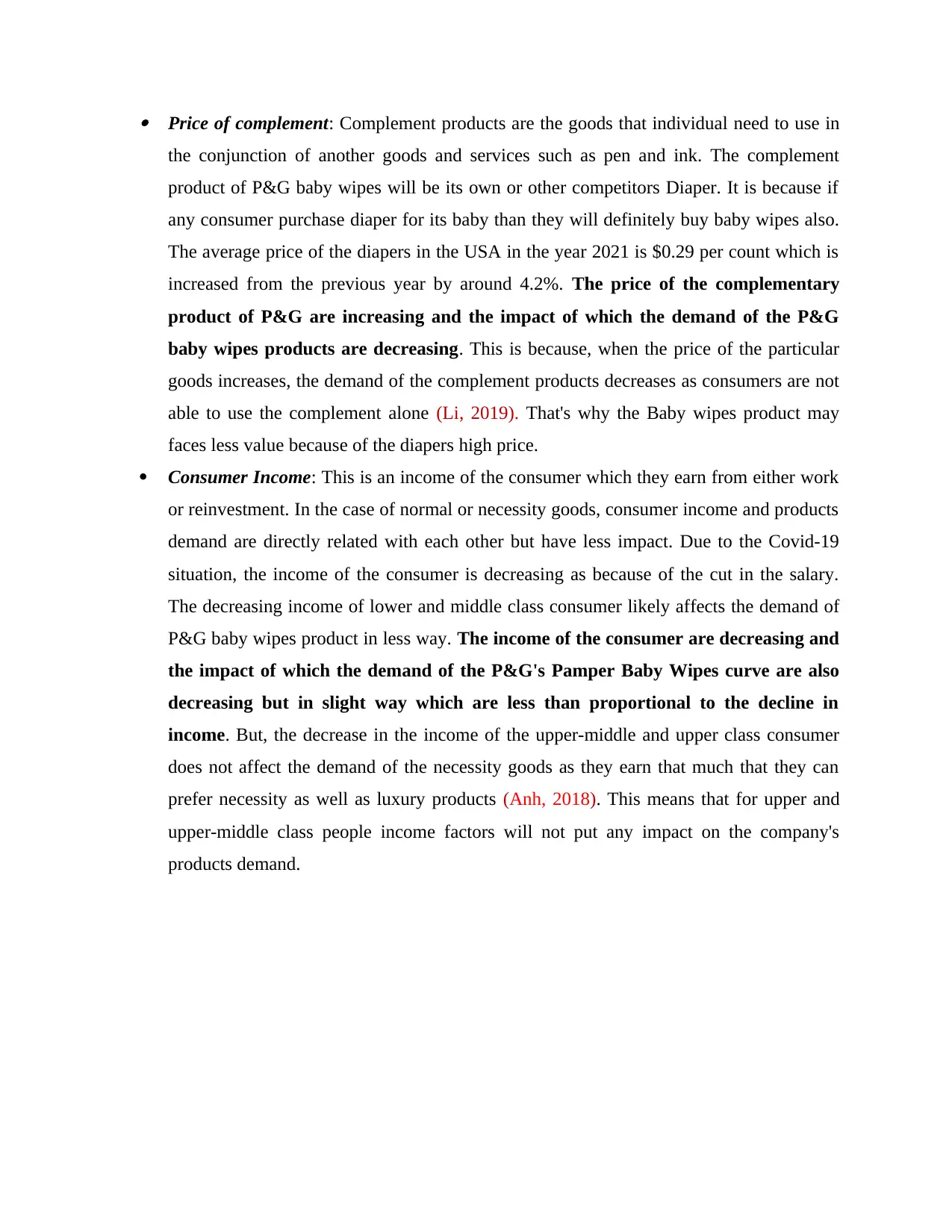
Price of complement: Complement products are the goods that individual need to use in
the conjunction of another goods and services such as pen and ink. The complement
product of P&G baby wipes will be its own or other competitors Diaper. It is because if
any consumer purchase diaper for its baby than they will definitely buy baby wipes also.
The average price of the diapers in the USA in the year 2021 is $0.29 per count which is
increased from the previous year by around 4.2%. The price of the complementary
product of P&G are increasing and the impact of which the demand of the P&G
baby wipes products are decreasing. This is because, when the price of the particular
goods increases, the demand of the complement products decreases as consumers are not
able to use the complement alone (Li, 2019). That's why the Baby wipes product may
faces less value because of the diapers high price.
Consumer Income: This is an income of the consumer which they earn from either work
or reinvestment. In the case of normal or necessity goods, consumer income and products
demand are directly related with each other but have less impact. Due to the Covid-19
situation, the income of the consumer is decreasing as because of the cut in the salary.
The decreasing income of lower and middle class consumer likely affects the demand of
P&G baby wipes product in less way. The income of the consumer are decreasing and
the impact of which the demand of the P&G's Pamper Baby Wipes curve are also
decreasing but in slight way which are less than proportional to the decline in
income. But, the decrease in the income of the upper-middle and upper class consumer
does not affect the demand of the necessity goods as they earn that much that they can
prefer necessity as well as luxury products (Anh, 2018). This means that for upper and
upper-middle class people income factors will not put any impact on the company's
products demand.
the conjunction of another goods and services such as pen and ink. The complement
product of P&G baby wipes will be its own or other competitors Diaper. It is because if
any consumer purchase diaper for its baby than they will definitely buy baby wipes also.
The average price of the diapers in the USA in the year 2021 is $0.29 per count which is
increased from the previous year by around 4.2%. The price of the complementary
product of P&G are increasing and the impact of which the demand of the P&G
baby wipes products are decreasing. This is because, when the price of the particular
goods increases, the demand of the complement products decreases as consumers are not
able to use the complement alone (Li, 2019). That's why the Baby wipes product may
faces less value because of the diapers high price.
Consumer Income: This is an income of the consumer which they earn from either work
or reinvestment. In the case of normal or necessity goods, consumer income and products
demand are directly related with each other but have less impact. Due to the Covid-19
situation, the income of the consumer is decreasing as because of the cut in the salary.
The decreasing income of lower and middle class consumer likely affects the demand of
P&G baby wipes product in less way. The income of the consumer are decreasing and
the impact of which the demand of the P&G's Pamper Baby Wipes curve are also
decreasing but in slight way which are less than proportional to the decline in
income. But, the decrease in the income of the upper-middle and upper class consumer
does not affect the demand of the necessity goods as they earn that much that they can
prefer necessity as well as luxury products (Anh, 2018). This means that for upper and
upper-middle class people income factors will not put any impact on the company's
products demand.
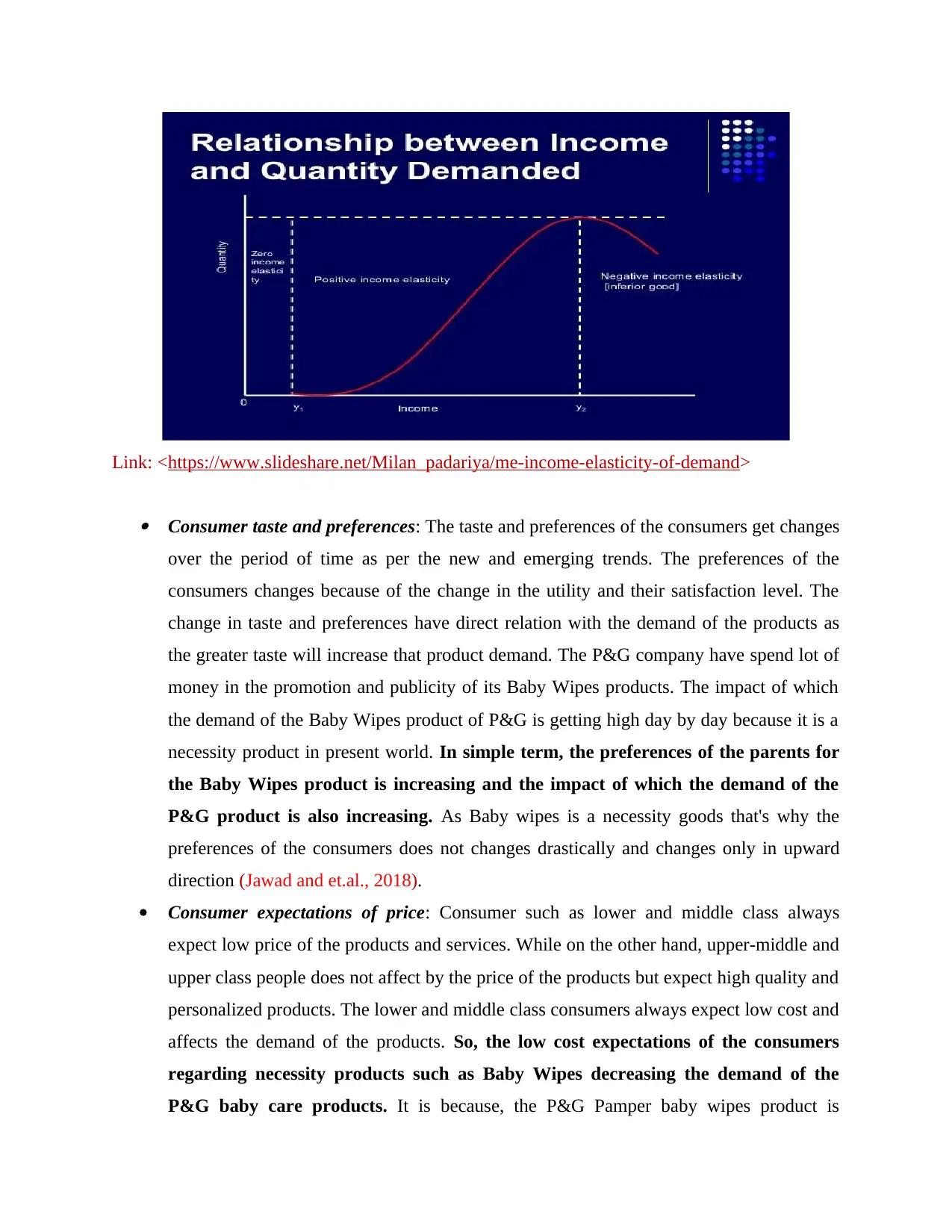
Link: <https://www.slideshare.net/Milan_padariya/me-income-elasticity-of-demand>
Consumer taste and preferences: The taste and preferences of the consumers get changes
over the period of time as per the new and emerging trends. The preferences of the
consumers changes because of the change in the utility and their satisfaction level. The
change in taste and preferences have direct relation with the demand of the products as
the greater taste will increase that product demand. The P&G company have spend lot of
money in the promotion and publicity of its Baby Wipes products. The impact of which
the demand of the Baby Wipes product of P&G is getting high day by day because it is a
necessity product in present world. In simple term, the preferences of the parents for
the Baby Wipes product is increasing and the impact of which the demand of the
P&G product is also increasing. As Baby wipes is a necessity goods that's why the
preferences of the consumers does not changes drastically and changes only in upward
direction (Jawad and et.al., 2018).
Consumer expectations of price: Consumer such as lower and middle class always
expect low price of the products and services. While on the other hand, upper-middle and
upper class people does not affect by the price of the products but expect high quality and
personalized products. The lower and middle class consumers always expect low cost and
affects the demand of the products. So, the low cost expectations of the consumers
regarding necessity products such as Baby Wipes decreasing the demand of the
P&G baby care products. It is because, the P&G Pamper baby wipes product is
Consumer taste and preferences: The taste and preferences of the consumers get changes
over the period of time as per the new and emerging trends. The preferences of the
consumers changes because of the change in the utility and their satisfaction level. The
change in taste and preferences have direct relation with the demand of the products as
the greater taste will increase that product demand. The P&G company have spend lot of
money in the promotion and publicity of its Baby Wipes products. The impact of which
the demand of the Baby Wipes product of P&G is getting high day by day because it is a
necessity product in present world. In simple term, the preferences of the parents for
the Baby Wipes product is increasing and the impact of which the demand of the
P&G product is also increasing. As Baby wipes is a necessity goods that's why the
preferences of the consumers does not changes drastically and changes only in upward
direction (Jawad and et.al., 2018).
Consumer expectations of price: Consumer such as lower and middle class always
expect low price of the products and services. While on the other hand, upper-middle and
upper class people does not affect by the price of the products but expect high quality and
personalized products. The lower and middle class consumers always expect low cost and
affects the demand of the products. So, the low cost expectations of the consumers
regarding necessity products such as Baby Wipes decreasing the demand of the
P&G baby care products. It is because, the P&G Pamper baby wipes product is
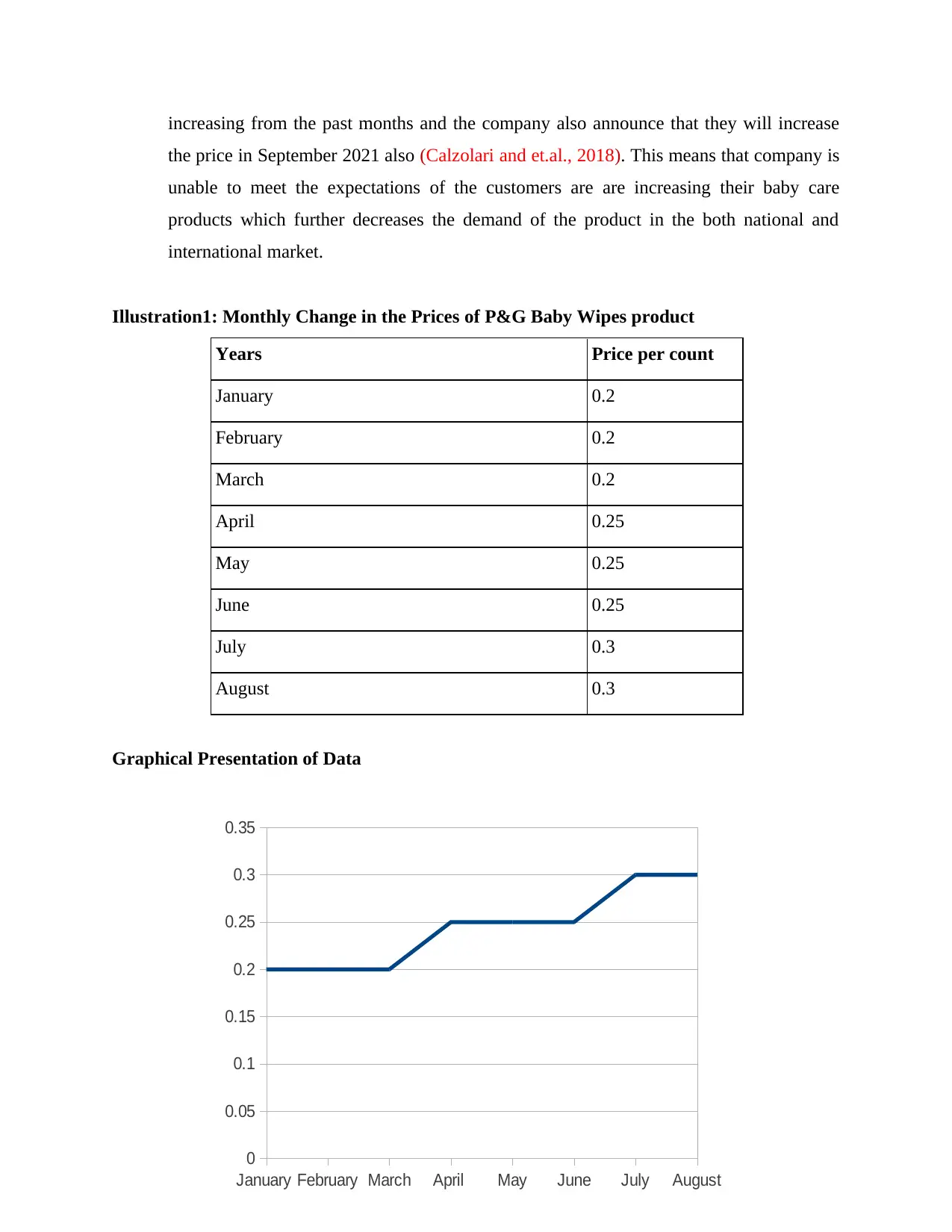
increasing from the past months and the company also announce that they will increase
the price in September 2021 also (Calzolari and et.al., 2018). This means that company is
unable to meet the expectations of the customers are are increasing their baby care
products which further decreases the demand of the product in the both national and
international market.
Illustration1: Monthly Change in the Prices of P&G Baby Wipes product
Years Price per count
January 0.2
February 0.2
March 0.2
April 0.25
May 0.25
June 0.25
July 0.3
August 0.3
Graphical Presentation of Data
January February March April May June July August
0
0.05
0.1
0.15
0.2
0.25
0.3
0.35
the price in September 2021 also (Calzolari and et.al., 2018). This means that company is
unable to meet the expectations of the customers are are increasing their baby care
products which further decreases the demand of the product in the both national and
international market.
Illustration1: Monthly Change in the Prices of P&G Baby Wipes product
Years Price per count
January 0.2
February 0.2
March 0.2
April 0.25
May 0.25
June 0.25
July 0.3
August 0.3
Graphical Presentation of Data
January February March April May June July August
0
0.05
0.1
0.15
0.2
0.25
0.3
0.35
Paraphrase This Document
Need a fresh take? Get an instant paraphrase of this document with our AI Paraphraser
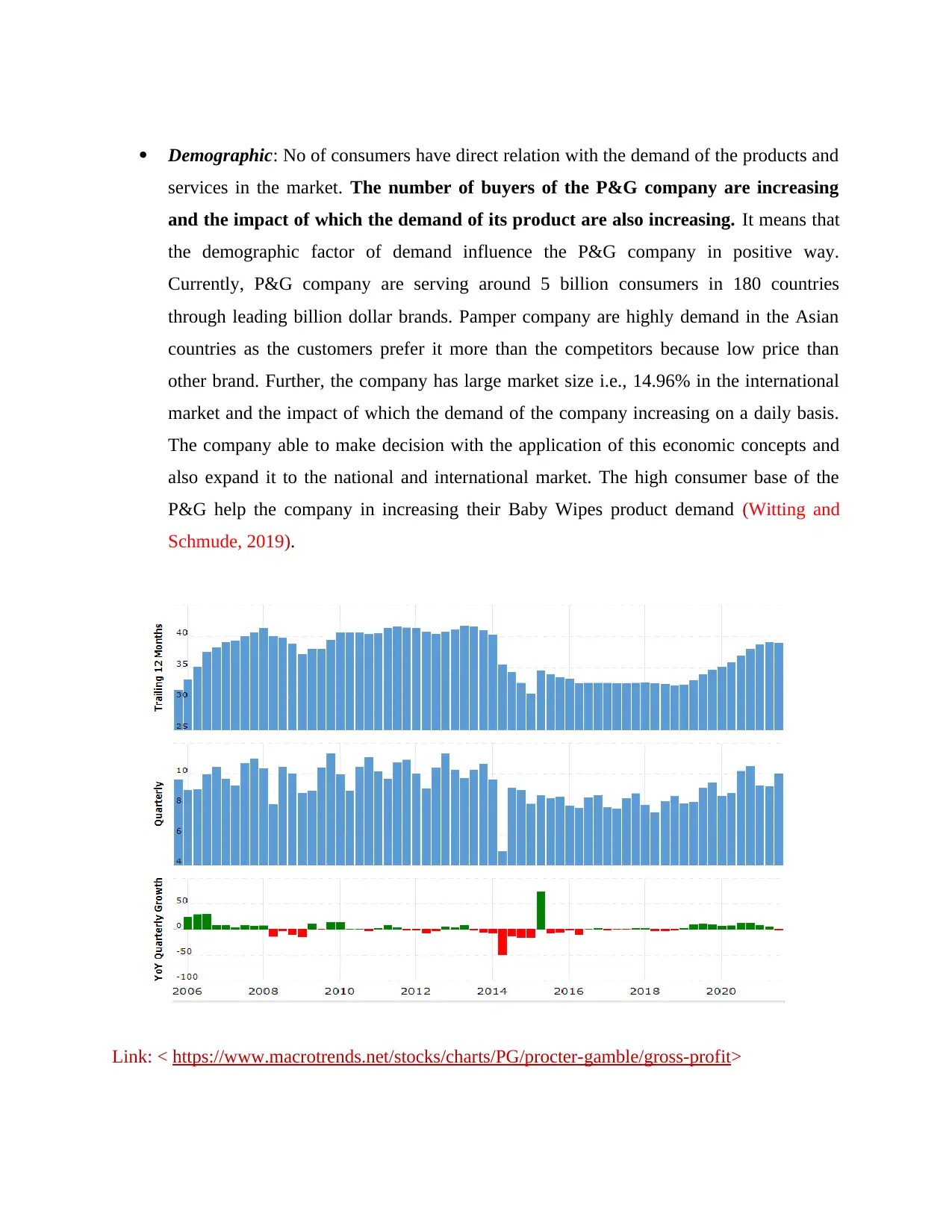
Demographic: No of consumers have direct relation with the demand of the products and
services in the market. The number of buyers of the P&G company are increasing
and the impact of which the demand of its product are also increasing. It means that
the demographic factor of demand influence the P&G company in positive way.
Currently, P&G company are serving around 5 billion consumers in 180 countries
through leading billion dollar brands. Pamper company are highly demand in the Asian
countries as the customers prefer it more than the competitors because low price than
other brand. Further, the company has large market size i.e., 14.96% in the international
market and the impact of which the demand of the company increasing on a daily basis.
The company able to make decision with the application of this economic concepts and
also expand it to the national and international market. The high consumer base of the
P&G help the company in increasing their Baby Wipes product demand (Witting and
Schmude, 2019).
Link: < https://www.macrotrends.net/stocks/charts/PG/procter-gamble/gross-profit>
services in the market. The number of buyers of the P&G company are increasing
and the impact of which the demand of its product are also increasing. It means that
the demographic factor of demand influence the P&G company in positive way.
Currently, P&G company are serving around 5 billion consumers in 180 countries
through leading billion dollar brands. Pamper company are highly demand in the Asian
countries as the customers prefer it more than the competitors because low price than
other brand. Further, the company has large market size i.e., 14.96% in the international
market and the impact of which the demand of the company increasing on a daily basis.
The company able to make decision with the application of this economic concepts and
also expand it to the national and international market. The high consumer base of the
P&G help the company in increasing their Baby Wipes product demand (Witting and
Schmude, 2019).
Link: < https://www.macrotrends.net/stocks/charts/PG/procter-gamble/gross-profit>
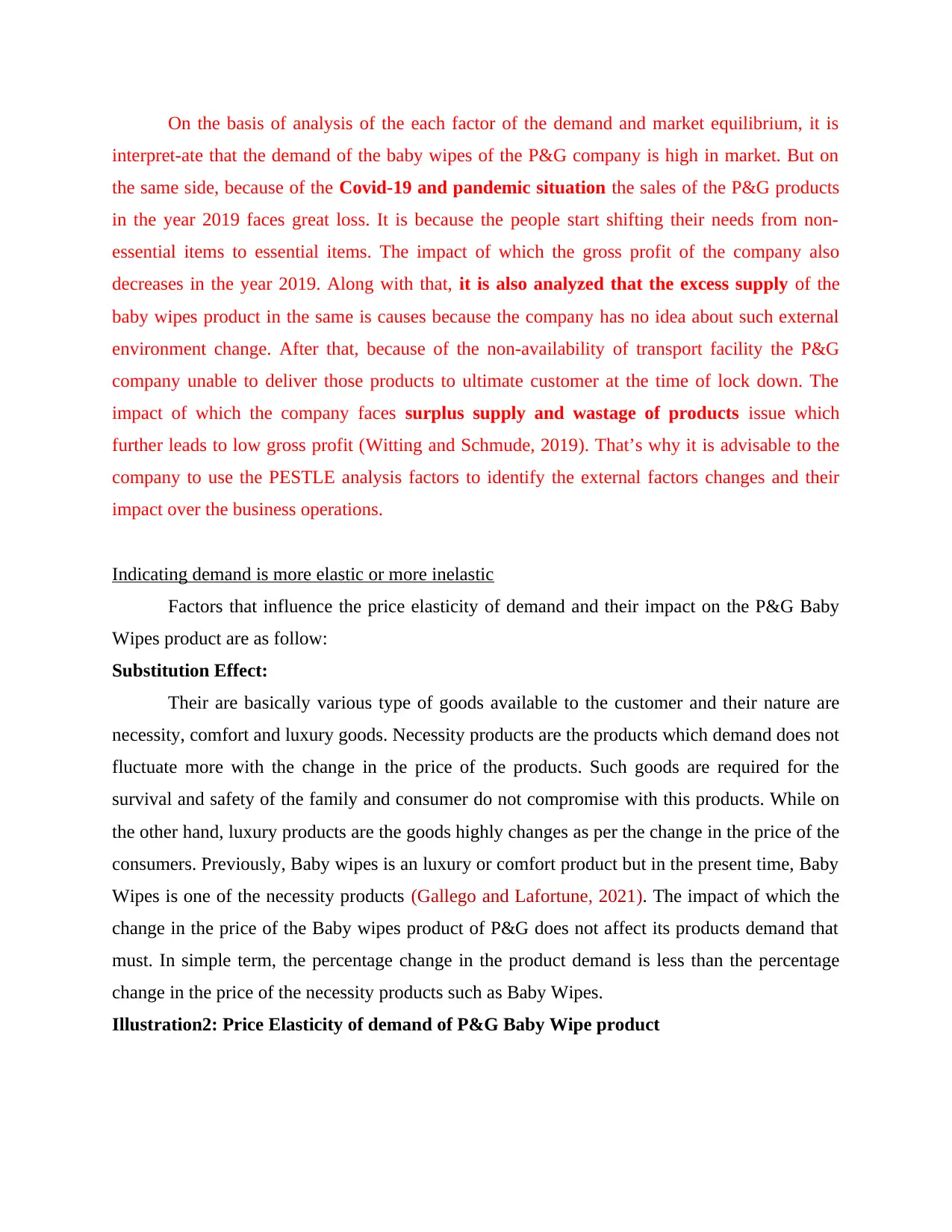
On the basis of analysis of the each factor of the demand and market equilibrium, it is
interpret-ate that the demand of the baby wipes of the P&G company is high in market. But on
the same side, because of the Covid-19 and pandemic situation the sales of the P&G products
in the year 2019 faces great loss. It is because the people start shifting their needs from non-
essential items to essential items. The impact of which the gross profit of the company also
decreases in the year 2019. Along with that, it is also analyzed that the excess supply of the
baby wipes product in the same is causes because the company has no idea about such external
environment change. After that, because of the non-availability of transport facility the P&G
company unable to deliver those products to ultimate customer at the time of lock down. The
impact of which the company faces surplus supply and wastage of products issue which
further leads to low gross profit (Witting and Schmude, 2019). That’s why it is advisable to the
company to use the PESTLE analysis factors to identify the external factors changes and their
impact over the business operations.
Indicating demand is more elastic or more inelastic
Factors that influence the price elasticity of demand and their impact on the P&G Baby
Wipes product are as follow:
Substitution Effect:
Their are basically various type of goods available to the customer and their nature are
necessity, comfort and luxury goods. Necessity products are the products which demand does not
fluctuate more with the change in the price of the products. Such goods are required for the
survival and safety of the family and consumer do not compromise with this products. While on
the other hand, luxury products are the goods highly changes as per the change in the price of the
consumers. Previously, Baby wipes is an luxury or comfort product but in the present time, Baby
Wipes is one of the necessity products (Gallego and Lafortune, 2021). The impact of which the
change in the price of the Baby wipes product of P&G does not affect its products demand that
must. In simple term, the percentage change in the product demand is less than the percentage
change in the price of the necessity products such as Baby Wipes.
Illustration2: Price Elasticity of demand of P&G Baby Wipe product
interpret-ate that the demand of the baby wipes of the P&G company is high in market. But on
the same side, because of the Covid-19 and pandemic situation the sales of the P&G products
in the year 2019 faces great loss. It is because the people start shifting their needs from non-
essential items to essential items. The impact of which the gross profit of the company also
decreases in the year 2019. Along with that, it is also analyzed that the excess supply of the
baby wipes product in the same is causes because the company has no idea about such external
environment change. After that, because of the non-availability of transport facility the P&G
company unable to deliver those products to ultimate customer at the time of lock down. The
impact of which the company faces surplus supply and wastage of products issue which
further leads to low gross profit (Witting and Schmude, 2019). That’s why it is advisable to the
company to use the PESTLE analysis factors to identify the external factors changes and their
impact over the business operations.
Indicating demand is more elastic or more inelastic
Factors that influence the price elasticity of demand and their impact on the P&G Baby
Wipes product are as follow:
Substitution Effect:
Their are basically various type of goods available to the customer and their nature are
necessity, comfort and luxury goods. Necessity products are the products which demand does not
fluctuate more with the change in the price of the products. Such goods are required for the
survival and safety of the family and consumer do not compromise with this products. While on
the other hand, luxury products are the goods highly changes as per the change in the price of the
consumers. Previously, Baby wipes is an luxury or comfort product but in the present time, Baby
Wipes is one of the necessity products (Gallego and Lafortune, 2021). The impact of which the
change in the price of the Baby wipes product of P&G does not affect its products demand that
must. In simple term, the percentage change in the product demand is less than the percentage
change in the price of the necessity products such as Baby Wipes.
Illustration2: Price Elasticity of demand of P&G Baby Wipe product
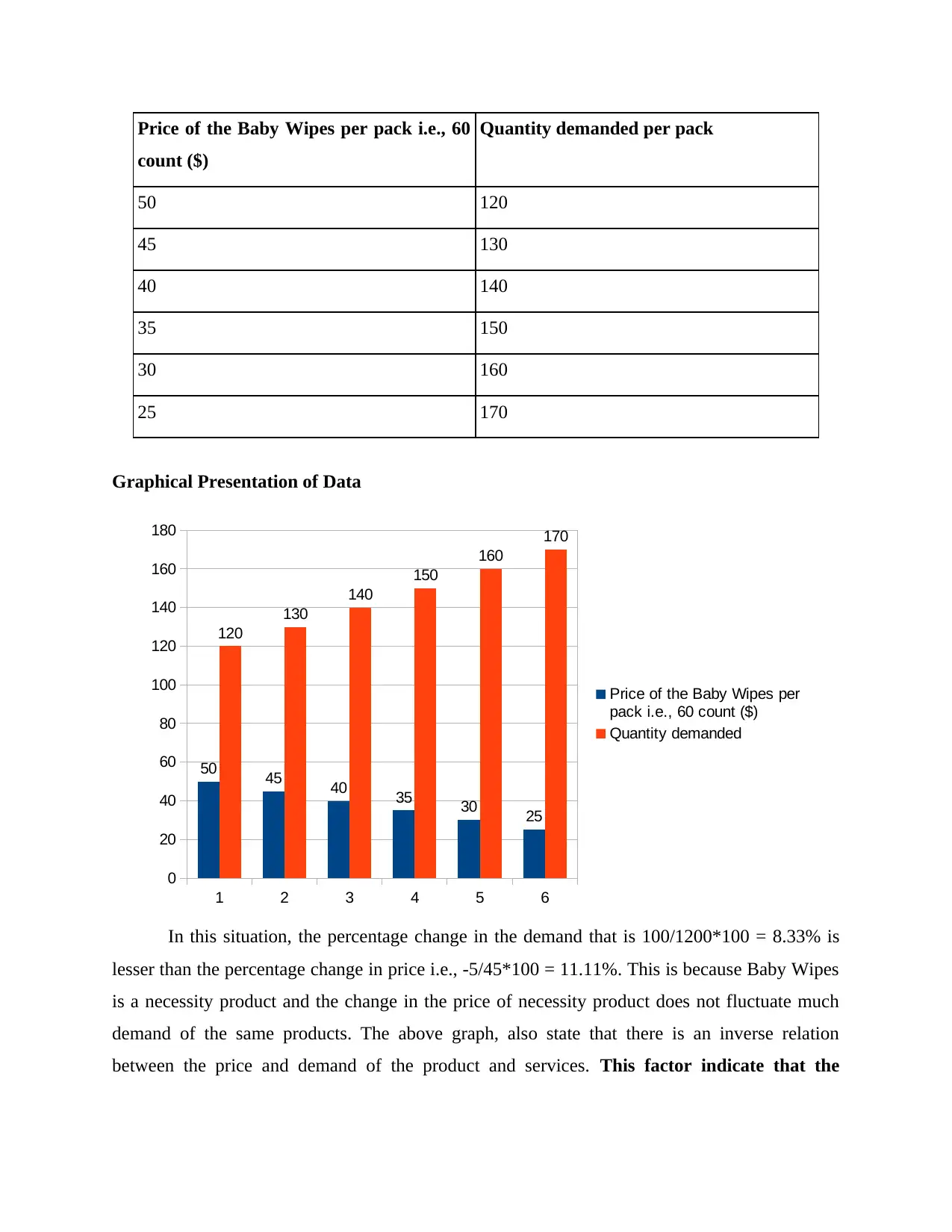
Price of the Baby Wipes per pack i.e., 60
count ($)
Quantity demanded per pack
50 120
45 130
40 140
35 150
30 160
25 170
Graphical Presentation of Data
In this situation, the percentage change in the demand that is 100/1200*100 = 8.33% is
lesser than the percentage change in price i.e., -5/45*100 = 11.11%. This is because Baby Wipes
is a necessity product and the change in the price of necessity product does not fluctuate much
demand of the same products. The above graph, also state that there is an inverse relation
between the price and demand of the product and services. This factor indicate that the
1 2 3 4 5 6
0
20
40
60
80
100
120
140
160
180
50 45 40 35 30 25
120
130
140
150
160
170
Price of the Baby Wipes per
pack i.e., 60 count ($)
Quantity demanded
count ($)
Quantity demanded per pack
50 120
45 130
40 140
35 150
30 160
25 170
Graphical Presentation of Data
In this situation, the percentage change in the demand that is 100/1200*100 = 8.33% is
lesser than the percentage change in price i.e., -5/45*100 = 11.11%. This is because Baby Wipes
is a necessity product and the change in the price of necessity product does not fluctuate much
demand of the same products. The above graph, also state that there is an inverse relation
between the price and demand of the product and services. This factor indicate that the
1 2 3 4 5 6
0
20
40
60
80
100
120
140
160
180
50 45 40 35 30 25
120
130
140
150
160
170
Price of the Baby Wipes per
pack i.e., 60 count ($)
Quantity demanded
Secure Best Marks with AI Grader
Need help grading? Try our AI Grader for instant feedback on your assignments.
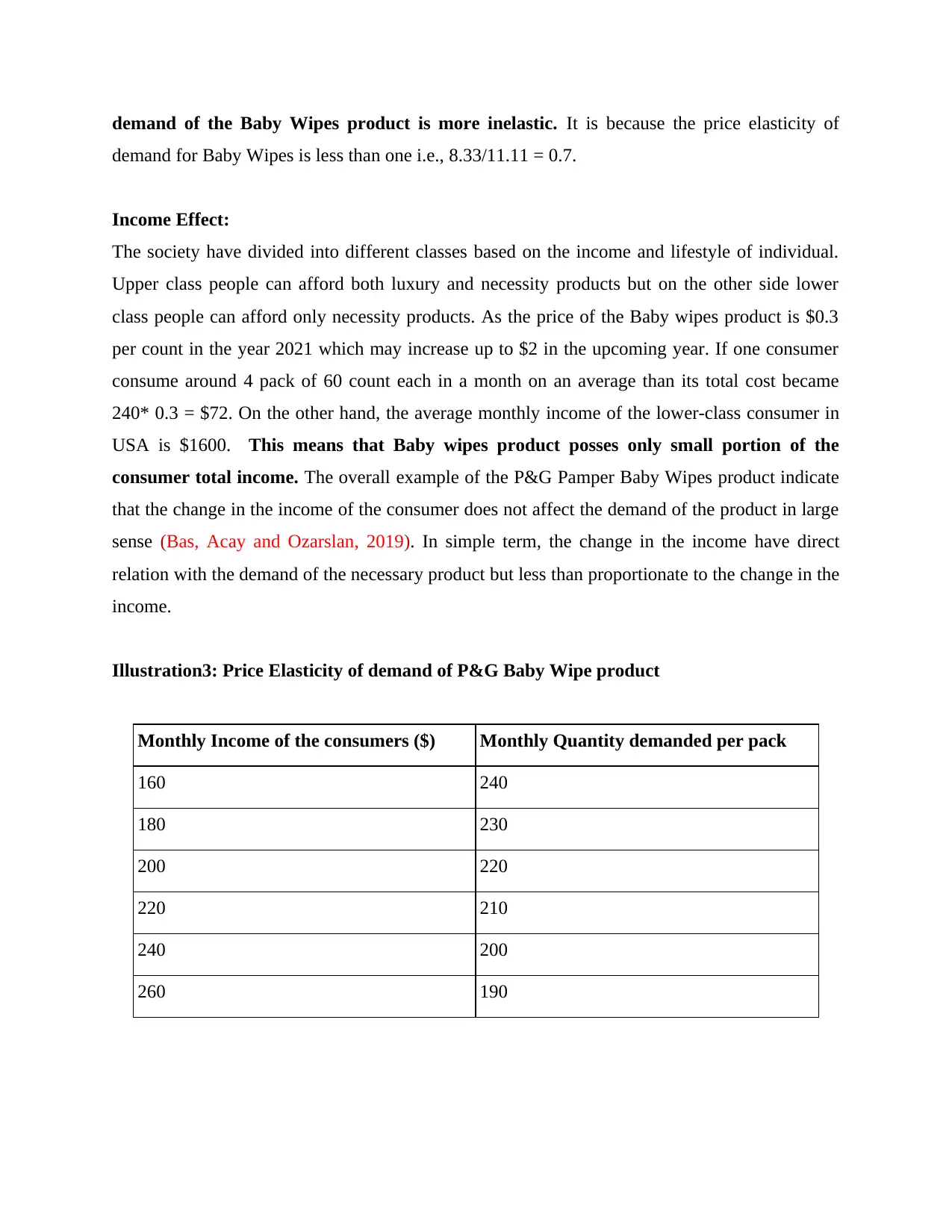
demand of the Baby Wipes product is more inelastic. It is because the price elasticity of
demand for Baby Wipes is less than one i.e., 8.33/11.11 = 0.7.
Income Effect:
The society have divided into different classes based on the income and lifestyle of individual.
Upper class people can afford both luxury and necessity products but on the other side lower
class people can afford only necessity products. As the price of the Baby wipes product is $0.3
per count in the year 2021 which may increase up to $2 in the upcoming year. If one consumer
consume around 4 pack of 60 count each in a month on an average than its total cost became
240* 0.3 = $72. On the other hand, the average monthly income of the lower-class consumer in
USA is $1600. This means that Baby wipes product posses only small portion of the
consumer total income. The overall example of the P&G Pamper Baby Wipes product indicate
that the change in the income of the consumer does not affect the demand of the product in large
sense (Bas, Acay and Ozarslan, 2019). In simple term, the change in the income have direct
relation with the demand of the necessary product but less than proportionate to the change in the
income.
Illustration3: Price Elasticity of demand of P&G Baby Wipe product
Monthly Income of the consumers ($) Monthly Quantity demanded per pack
160 240
180 230
200 220
220 210
240 200
260 190
demand for Baby Wipes is less than one i.e., 8.33/11.11 = 0.7.
Income Effect:
The society have divided into different classes based on the income and lifestyle of individual.
Upper class people can afford both luxury and necessity products but on the other side lower
class people can afford only necessity products. As the price of the Baby wipes product is $0.3
per count in the year 2021 which may increase up to $2 in the upcoming year. If one consumer
consume around 4 pack of 60 count each in a month on an average than its total cost became
240* 0.3 = $72. On the other hand, the average monthly income of the lower-class consumer in
USA is $1600. This means that Baby wipes product posses only small portion of the
consumer total income. The overall example of the P&G Pamper Baby Wipes product indicate
that the change in the income of the consumer does not affect the demand of the product in large
sense (Bas, Acay and Ozarslan, 2019). In simple term, the change in the income have direct
relation with the demand of the necessary product but less than proportionate to the change in the
income.
Illustration3: Price Elasticity of demand of P&G Baby Wipe product
Monthly Income of the consumers ($) Monthly Quantity demanded per pack
160 240
180 230
200 220
220 210
240 200
260 190

Graphical Presentation of Data
On the basis of above illustration and graph, it can interpretable that the percentage in
Baby Wipes demand (necessary products) i.e., -10/240* 100 = 4.17% is lesser than the change in
the income of the consumer i.e., 20/160*100 = 12.5%. Basically, there is an inverse relation
between the income of the consumer and demand of the necessity i.e., Baby wipes products. So,
this factor indicate that the demand of P&G company's baby wipes product is also more
inelastic. It is because the income elasticity of demand for Baby Wipes product is also less than
one i.e., 4.17/12.5 = 0.3.
1 2 3 4 5 6
0
50
100
150
200
250
300
160
180
200
220
240
260
240 230 220 210 200 190
Monthly Income of the
consumers ($)
Monthly Quantity demanded
per pack
On the basis of above illustration and graph, it can interpretable that the percentage in
Baby Wipes demand (necessary products) i.e., -10/240* 100 = 4.17% is lesser than the change in
the income of the consumer i.e., 20/160*100 = 12.5%. Basically, there is an inverse relation
between the income of the consumer and demand of the necessity i.e., Baby wipes products. So,
this factor indicate that the demand of P&G company's baby wipes product is also more
inelastic. It is because the income elasticity of demand for Baby Wipes product is also less than
one i.e., 4.17/12.5 = 0.3.
1 2 3 4 5 6
0
50
100
150
200
250
300
160
180
200
220
240
260
240 230 220 210 200 190
Monthly Income of the
consumers ($)
Monthly Quantity demanded
per pack
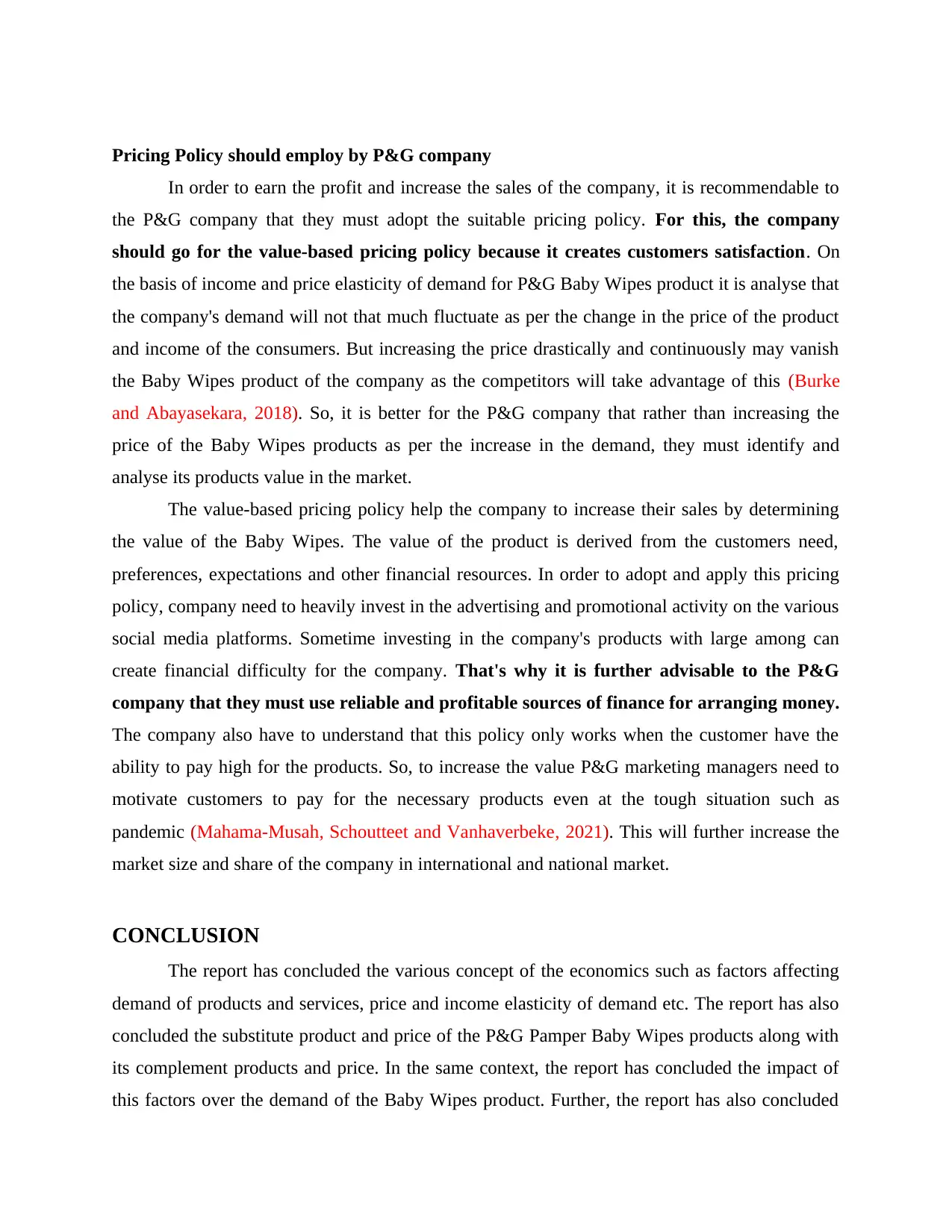
Pricing Policy should employ by P&G company
In order to earn the profit and increase the sales of the company, it is recommendable to
the P&G company that they must adopt the suitable pricing policy. For this, the company
should go for the value-based pricing policy because it creates customers satisfaction. On
the basis of income and price elasticity of demand for P&G Baby Wipes product it is analyse that
the company's demand will not that much fluctuate as per the change in the price of the product
and income of the consumers. But increasing the price drastically and continuously may vanish
the Baby Wipes product of the company as the competitors will take advantage of this (Burke
and Abayasekara, 2018). So, it is better for the P&G company that rather than increasing the
price of the Baby Wipes products as per the increase in the demand, they must identify and
analyse its products value in the market.
The value-based pricing policy help the company to increase their sales by determining
the value of the Baby Wipes. The value of the product is derived from the customers need,
preferences, expectations and other financial resources. In order to adopt and apply this pricing
policy, company need to heavily invest in the advertising and promotional activity on the various
social media platforms. Sometime investing in the company's products with large among can
create financial difficulty for the company. That's why it is further advisable to the P&G
company that they must use reliable and profitable sources of finance for arranging money.
The company also have to understand that this policy only works when the customer have the
ability to pay high for the products. So, to increase the value P&G marketing managers need to
motivate customers to pay for the necessary products even at the tough situation such as
pandemic (Mahama-Musah, Schoutteet and Vanhaverbeke, 2021). This will further increase the
market size and share of the company in international and national market.
CONCLUSION
The report has concluded the various concept of the economics such as factors affecting
demand of products and services, price and income elasticity of demand etc. The report has also
concluded the substitute product and price of the P&G Pamper Baby Wipes products along with
its complement products and price. In the same context, the report has concluded the impact of
this factors over the demand of the Baby Wipes product. Further, the report has also concluded
In order to earn the profit and increase the sales of the company, it is recommendable to
the P&G company that they must adopt the suitable pricing policy. For this, the company
should go for the value-based pricing policy because it creates customers satisfaction. On
the basis of income and price elasticity of demand for P&G Baby Wipes product it is analyse that
the company's demand will not that much fluctuate as per the change in the price of the product
and income of the consumers. But increasing the price drastically and continuously may vanish
the Baby Wipes product of the company as the competitors will take advantage of this (Burke
and Abayasekara, 2018). So, it is better for the P&G company that rather than increasing the
price of the Baby Wipes products as per the increase in the demand, they must identify and
analyse its products value in the market.
The value-based pricing policy help the company to increase their sales by determining
the value of the Baby Wipes. The value of the product is derived from the customers need,
preferences, expectations and other financial resources. In order to adopt and apply this pricing
policy, company need to heavily invest in the advertising and promotional activity on the various
social media platforms. Sometime investing in the company's products with large among can
create financial difficulty for the company. That's why it is further advisable to the P&G
company that they must use reliable and profitable sources of finance for arranging money.
The company also have to understand that this policy only works when the customer have the
ability to pay high for the products. So, to increase the value P&G marketing managers need to
motivate customers to pay for the necessary products even at the tough situation such as
pandemic (Mahama-Musah, Schoutteet and Vanhaverbeke, 2021). This will further increase the
market size and share of the company in international and national market.
CONCLUSION
The report has concluded the various concept of the economics such as factors affecting
demand of products and services, price and income elasticity of demand etc. The report has also
concluded the substitute product and price of the P&G Pamper Baby Wipes products along with
its complement products and price. In the same context, the report has concluded the impact of
this factors over the demand of the Baby Wipes product. Further, the report has also concluded
Paraphrase This Document
Need a fresh take? Get an instant paraphrase of this document with our AI Paraphraser
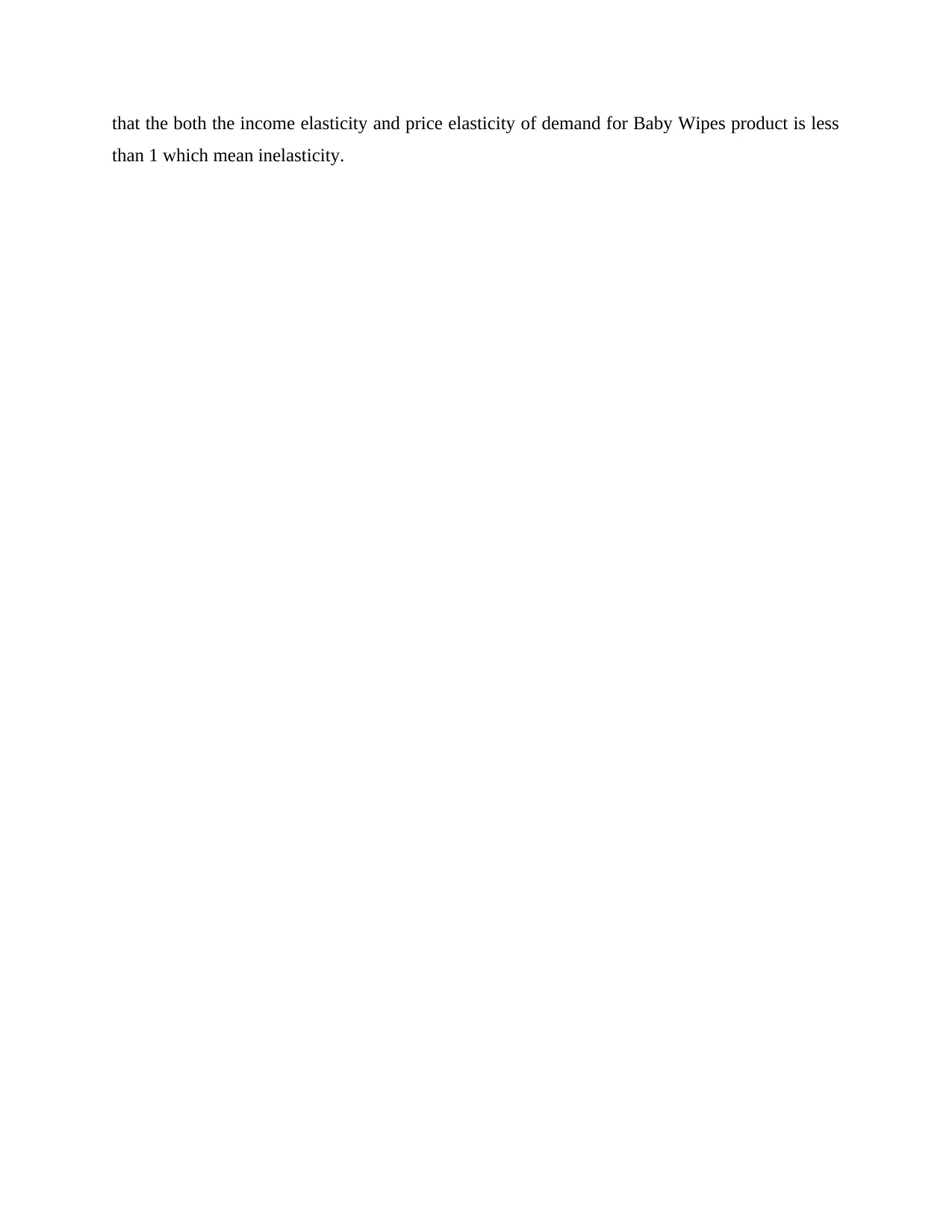
that the both the income elasticity and price elasticity of demand for Baby Wipes product is less
than 1 which mean inelasticity.
than 1 which mean inelasticity.

REFERENCES
Books and journals
Bashir, A. M. and et.al., 2019. Factors affecting consumers’ intention towards purchasing halal
food in South Africa: a structural equation modelling. Journal of Food Products
Marketing. 25(1). pp.26-48.
< https://www.tandfonline.com/doi/abs/10.1080/10454446.2018.1452813>
Sinaga, F. W. and Sinulingga, N. A. B., 2020. Factors Affecting Price and Quality of Products
on Purchase Decision. Journal of Economics and Business (JECOMBI). 1(1). pp.44-52.
< http://jecombi.seaninstitute.org/index.php/JECOMBI/article/view/7>
Aldaihani, F. M. F. and Ali, N. A., 2018. Factors affecting customer loyalty in the restaurant
service industry in Kuwait City, Kuwait. Journal of International Business and
Management. 1(2). pp.1-14.
< https://rpajournals.com/wp-content/uploads/2018/07/JIBM-2018-02-14-Faraj.pdf>
Li, J., 2019. ESSAYS ON PRODUCT INCOMPATIBILITY AND COLLUSION
DETECTING (Doctoral dissertation, Johns Hopkins University).
<https://jscholarship.library.jhu.edu/handle/1774.2/62196>
Anh, T. T. T., 2018. Factors affecting purchase intention on smartphone with the moderating
effect of brand origin-The case of Iphone (Doctoral dissertation, International
University-HCMC).
< http://keep.hcmiu.edu.vn/handle/123456789/3382>
Jawad, M. and et.al., 2018. Price elasticity of demand of non-cigarette tobacco products: a
systematic review and meta-analysis. Tobacco control. 27(6). pp.689-695.
< https://tobaccocontrol.bmj.com/content/27/6/689?papetoc=>
Calzolari, G. and et.al., 2018. Inelastic buyers and competition. The economic journal. 128(615).
pp.2843-2875.
1
Books and journals
Bashir, A. M. and et.al., 2019. Factors affecting consumers’ intention towards purchasing halal
food in South Africa: a structural equation modelling. Journal of Food Products
Marketing. 25(1). pp.26-48.
< https://www.tandfonline.com/doi/abs/10.1080/10454446.2018.1452813>
Sinaga, F. W. and Sinulingga, N. A. B., 2020. Factors Affecting Price and Quality of Products
on Purchase Decision. Journal of Economics and Business (JECOMBI). 1(1). pp.44-52.
< http://jecombi.seaninstitute.org/index.php/JECOMBI/article/view/7>
Aldaihani, F. M. F. and Ali, N. A., 2018. Factors affecting customer loyalty in the restaurant
service industry in Kuwait City, Kuwait. Journal of International Business and
Management. 1(2). pp.1-14.
< https://rpajournals.com/wp-content/uploads/2018/07/JIBM-2018-02-14-Faraj.pdf>
Li, J., 2019. ESSAYS ON PRODUCT INCOMPATIBILITY AND COLLUSION
DETECTING (Doctoral dissertation, Johns Hopkins University).
<https://jscholarship.library.jhu.edu/handle/1774.2/62196>
Anh, T. T. T., 2018. Factors affecting purchase intention on smartphone with the moderating
effect of brand origin-The case of Iphone (Doctoral dissertation, International
University-HCMC).
< http://keep.hcmiu.edu.vn/handle/123456789/3382>
Jawad, M. and et.al., 2018. Price elasticity of demand of non-cigarette tobacco products: a
systematic review and meta-analysis. Tobacco control. 27(6). pp.689-695.
< https://tobaccocontrol.bmj.com/content/27/6/689?papetoc=>
Calzolari, G. and et.al., 2018. Inelastic buyers and competition. The economic journal. 128(615).
pp.2843-2875.
1
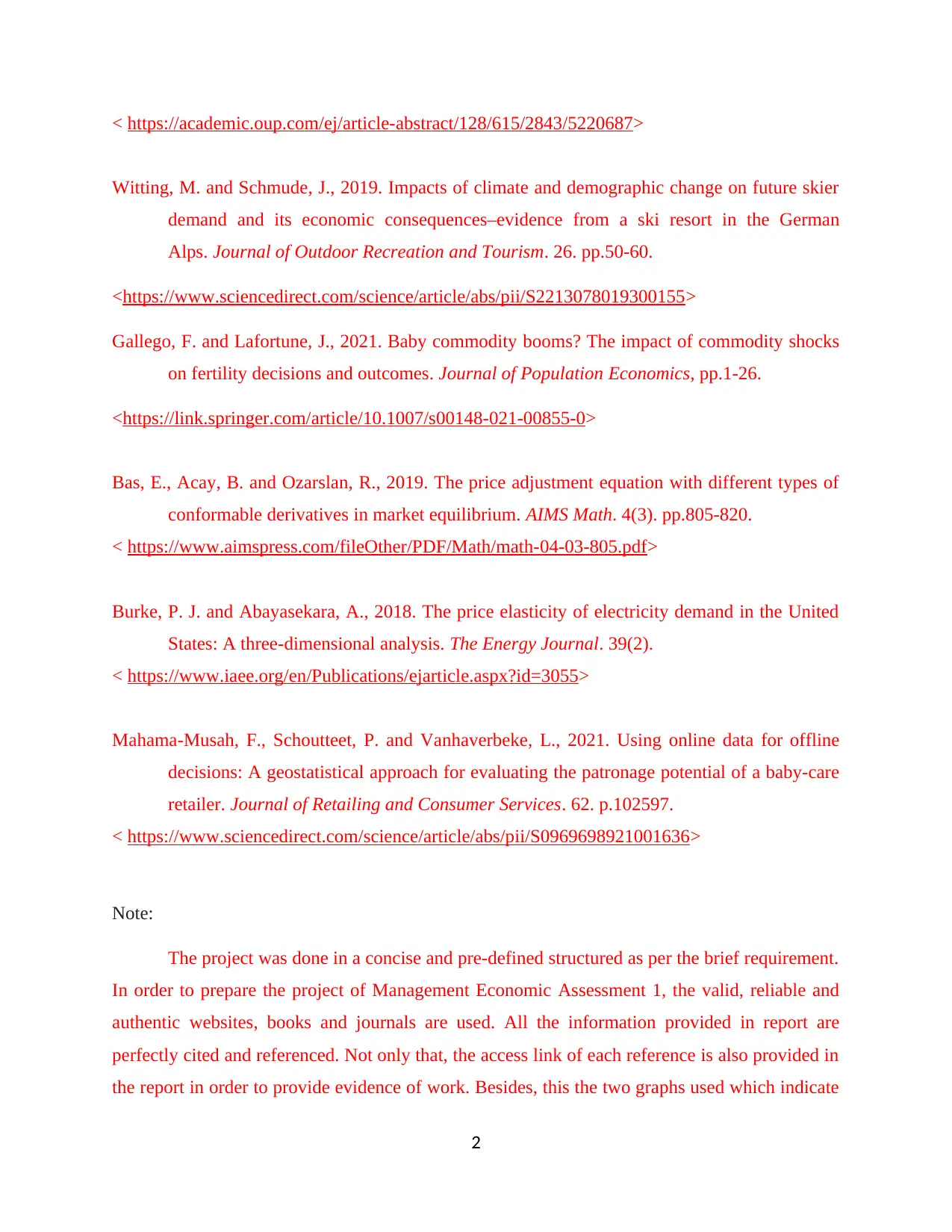
< https://academic.oup.com/ej/article-abstract/128/615/2843/5220687>
Witting, M. and Schmude, J., 2019. Impacts of climate and demographic change on future skier
demand and its economic consequences–evidence from a ski resort in the German
Alps. Journal of Outdoor Recreation and Tourism. 26. pp.50-60.
<https://www.sciencedirect.com/science/article/abs/pii/S2213078019300155>
Gallego, F. and Lafortune, J., 2021. Baby commodity booms? The impact of commodity shocks
on fertility decisions and outcomes. Journal of Population Economics, pp.1-26.
<https://link.springer.com/article/10.1007/s00148-021-00855-0>
Bas, E., Acay, B. and Ozarslan, R., 2019. The price adjustment equation with different types of
conformable derivatives in market equilibrium. AIMS Math. 4(3). pp.805-820.
< https://www.aimspress.com/fileOther/PDF/Math/math-04-03-805.pdf>
Burke, P. J. and Abayasekara, A., 2018. The price elasticity of electricity demand in the United
States: A three-dimensional analysis. The Energy Journal. 39(2).
< https://www.iaee.org/en/Publications/ejarticle.aspx?id=3055>
Mahama-Musah, F., Schoutteet, P. and Vanhaverbeke, L., 2021. Using online data for offline
decisions: A geostatistical approach for evaluating the patronage potential of a baby-care
retailer. Journal of Retailing and Consumer Services. 62. p.102597.
< https://www.sciencedirect.com/science/article/abs/pii/S0969698921001636>
Note:
The project was done in a concise and pre-defined structured as per the brief requirement.
In order to prepare the project of Management Economic Assessment 1, the valid, reliable and
authentic websites, books and journals are used. All the information provided in report are
perfectly cited and referenced. Not only that, the access link of each reference is also provided in
the report in order to provide evidence of work. Besides, this the two graphs used which indicate
2
Witting, M. and Schmude, J., 2019. Impacts of climate and demographic change on future skier
demand and its economic consequences–evidence from a ski resort in the German
Alps. Journal of Outdoor Recreation and Tourism. 26. pp.50-60.
<https://www.sciencedirect.com/science/article/abs/pii/S2213078019300155>
Gallego, F. and Lafortune, J., 2021. Baby commodity booms? The impact of commodity shocks
on fertility decisions and outcomes. Journal of Population Economics, pp.1-26.
<https://link.springer.com/article/10.1007/s00148-021-00855-0>
Bas, E., Acay, B. and Ozarslan, R., 2019. The price adjustment equation with different types of
conformable derivatives in market equilibrium. AIMS Math. 4(3). pp.805-820.
< https://www.aimspress.com/fileOther/PDF/Math/math-04-03-805.pdf>
Burke, P. J. and Abayasekara, A., 2018. The price elasticity of electricity demand in the United
States: A three-dimensional analysis. The Energy Journal. 39(2).
< https://www.iaee.org/en/Publications/ejarticle.aspx?id=3055>
Mahama-Musah, F., Schoutteet, P. and Vanhaverbeke, L., 2021. Using online data for offline
decisions: A geostatistical approach for evaluating the patronage potential of a baby-care
retailer. Journal of Retailing and Consumer Services. 62. p.102597.
< https://www.sciencedirect.com/science/article/abs/pii/S0969698921001636>
Note:
The project was done in a concise and pre-defined structured as per the brief requirement.
In order to prepare the project of Management Economic Assessment 1, the valid, reliable and
authentic websites, books and journals are used. All the information provided in report are
perfectly cited and referenced. Not only that, the access link of each reference is also provided in
the report in order to provide evidence of work. Besides, this the two graphs used which indicate
2
Secure Best Marks with AI Grader
Need help grading? Try our AI Grader for instant feedback on your assignments.

the sales and gross profit of the P&G company are also provided via link in order to access it
properly. Further, to make the project more practical and presentable, the information is provided
with practical illustrations.
The illustrations include price elasticity of demand, monthly change in price. The data of
illustration are taken on hypothetical basis because such information regarding P&G company
are not available on any websites. But the information is fully depending upon the deep research
and understanding of market and economics concepts. In simple term, the project was prepared
by understanding and researching the various terms and factors of economics which affects the
demand of the company’s products. All the information of the P&G company, used to prepare
project are taken from authorized website. The reason behind the selection of P&G company for
my project is that I have always researched that this company is well-known for its employee’s
engagements and satisfaction.
As, I found out that P&G company is also listed in my project requirement so I choose it
because it gives me chance to know deep about the company. After company selection, I started
reading business news and articles along with economic times news to know about P&G
company products price, demand, supply etc. Now I read business news on daily business which
is a fact that I have become a passionate reader and it also help me in making my project one of
the best.
3
properly. Further, to make the project more practical and presentable, the information is provided
with practical illustrations.
The illustrations include price elasticity of demand, monthly change in price. The data of
illustration are taken on hypothetical basis because such information regarding P&G company
are not available on any websites. But the information is fully depending upon the deep research
and understanding of market and economics concepts. In simple term, the project was prepared
by understanding and researching the various terms and factors of economics which affects the
demand of the company’s products. All the information of the P&G company, used to prepare
project are taken from authorized website. The reason behind the selection of P&G company for
my project is that I have always researched that this company is well-known for its employee’s
engagements and satisfaction.
As, I found out that P&G company is also listed in my project requirement so I choose it
because it gives me chance to know deep about the company. After company selection, I started
reading business news and articles along with economic times news to know about P&G
company products price, demand, supply etc. Now I read business news on daily business which
is a fact that I have become a passionate reader and it also help me in making my project one of
the best.
3

4
1 out of 18
Your All-in-One AI-Powered Toolkit for Academic Success.
+13062052269
info@desklib.com
Available 24*7 on WhatsApp / Email
![[object Object]](/_next/static/media/star-bottom.7253800d.svg)
Unlock your academic potential
© 2024 | Zucol Services PVT LTD | All rights reserved.



